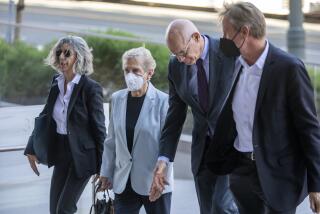Errol Flynn: a Hero or Villain?
- Share via
There is nothing there now but a dusty, vacant stretch of weed-studded land high in the Hollywood Hills. But still the star-struck and the curious come.
Once they made the trek up Nichols Canyon to a site just off Mulholland Drive to catch a glimpse of the rambling Connecticut-style farmhouse, designed by screen legend Errol Flynn. The house they could see, but like those who come today, they only could imagine the one-way mirrors in the bedroom ceilings and the listening device in the ladies room in a house that became known as the “fortress of bacchanalian amusements.”
It wasn’t the fact that Flynn slept there that intrigued Old Hollywood, it was with whom. For his many lovers were said to have included leading ladies, other men’s wives and a coterie of young ladies still eligible for Girl Scout badges.
It was here that a small group of Flynn’s friends pulled off one of Hollywood’s most notorious pranks. In 1942, after spending hours drowning their sorrows over the death of friend John Barrymore at a Sunset Strip bar, three of the mourners bribed the undertaker and headed back to Flynn’s house with Barrymore’s body. They propped it up in a chair and waited for their host to arrive after a late-night date. Flynn screamed upon seeing the body and hid in the oleander bush on the patio. He recovered quickly and poured drinks for his friends, but refused to help them return the body.
*
Such shenanigans were typical of Flynn, whose real life equaled the swashbuckling adventures of his movies. He was born in Tasmania in 1909, his mother from a seafaring family, his father a distinguished marine biologist.
A combination of accident and luck brought him to Hollywood after a film producer spotted him on an Australian beach.
In 1935, his first year at Warner Bros., he did very little except marry French actress Lili Damita. Their marriage would stagger through seven years of violent fights and the birth of their son, Sean, who in 1970 would disappear while working as a free-lance photographer in Cambodia.
Flynn stepped into overnight stardom after filming “Captain Blood.” Things came easily to him, including trouble and controversy.
Studio boss Jack Warner once said, “To the Walter Mittys of the world he was all the heroes in one magnificent, sexy animal package.”
The notorious San Francisco madam, Sally Stanford, said Flynn was “sweet” and a prodigious lover. “He was the only customer I ever had who tested all of the talent, including both shifts, twice. . . .”
Flynn’s roguish adventures, amorous escapades and bloody barroom brawls brought him into court on more than one occasion.
In November, 1942, at the pinnacle of his career, two teen-age girls accused him of statutory rape. A ponytailed teen-ager, Betty Hansen, sat on the witness stand detailing a night she spent with Flynn.
The second complainant, 16-year-old Peggy Satterlee, who everyone agreed looked at least five years older, charged that Flynn raped her on two consecutive nights on his yacht.
In a moment of high drama, the actor took the stand. A courtroom reporter wrote, “Flynn’s eyes were red-speckled, unslept, and his cheeks were chalk. His smile was patent, false. There were strings in his face, taut and extruded. More than anyone else in the courtroom, Flynn knew exactly what was at stake.”
As he finished his testimony, both girls were crying hysterically. Men yelled obscenities. The judge and bailiff attempted to “quell a near-riot.”
But his defense attorney, Jerry Giesler, had damaging information about both young women. Hansen had made no protest when Flynn locked the bedroom door and Satterlee had several affairs with married men and one abortion.
In his closing argument, Giesler stressed that the girls were lying to avoid felony charges for abortion and oral copulation. The prosecutor said Flynn had taken advantage of two innocent underage girls. After the jury of nine women and three men deliberated for more than 24 hours, they acquitted him on both charges.
But for the Hollywood legend, even vindication came with reviews. Before dismissing the jurors, the judge said, “I hope you’ve enjoyed this case as much as I have.”
Flynn found himself plastered all over the newspapers and the butt of jokes. “In like Flynn” became an indecent joke and a national cry amid grim war news.
His career thrived after the trial and he soon set sail for Mexico, with 17-year-old Nora Eddington, a redhead who sold cigarettes at the Hall of Justice. They had met during his trial. He married her and became the father of two girls, Deirdre and Rory. His second marriage would last seven years, precisely as his first did.
In 1950, before his movie-making began to decline, he married actress Patrice Wymore. A few years after their daughter, Arnella, was born, they separated and would remain so until his death in 1959. Flynn died a burned-out wreck at 50, his last 17-year-old nymphet at his side. And even death had its familiar consolations: His cronies buried him with six bottles of whiskey.
Before his fortress was torn down in 1988, it was owned by singer Ricky Nelson and singer-songwriter Stuart Hamblen, among others.
Today, the property is vacant and Flynn’s memory is preserved only by Flynn Drive and the affection of the film buffs who wander by and do what film buffs do best: imagine.
More to Read
The biggest entertainment stories
Get our big stories about Hollywood, film, television, music, arts, culture and more right in your inbox as soon as they publish.
You may occasionally receive promotional content from the Los Angeles Times.










